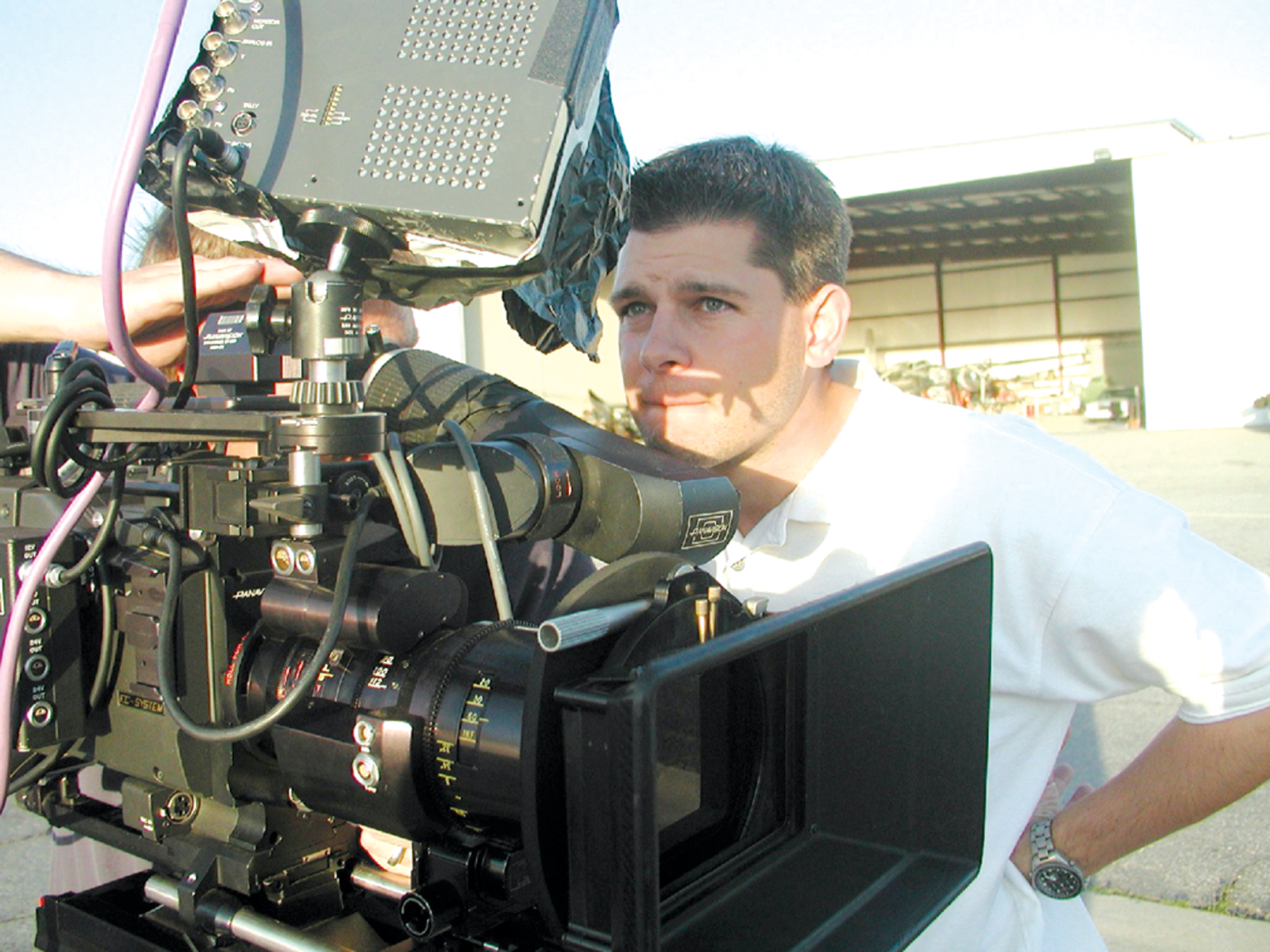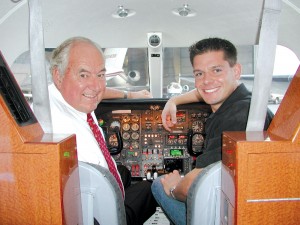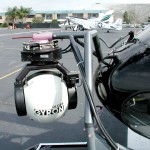By Fred “Crash” Blechman
Two names you’ll be hearing a lot about soon are “One Six Right” and Brian J. Terwilliger. The first is the name of the main runway at Van Nuys Airport (VNY), in the heart of the San Fernando Valley—part of Los Angeles—where more planes takeoff and land than any other general aviation airport in the world. It is also the name of a movie, soon to be seen in theatres, where flight enthusiasts, celebrities and aviation professionals have joined together to provide a high-quality film tracing the origin, passion, history and activities of this 75-year old airport.

Brian J. Terwilliger, producer/director of “One Six Right,” sets up for filming with Panavision’s high-definition state-of-the-art movie camera.
If the tarmac at Van Nuys Airport could talk, it would tell some incredible stories—about indelible scenes from the most famous motion pictures, world speed records, starlets who would one day become legends, and pioneer aircraft and those who flew them. It would talk about thousands of military missions and tens of thousands of flight lessons. Today, it would talk about more than half a million flight operations per year.
But the tarmac can’t talk. Instead, the telling of the VNY story is a long-overdue project undertaken by Brian J. Terwilliger, a 28-year-old filmmaker and pilot with a contagious passion for flying and an unparalleled penchant for perfection in story telling.
Terwilliger is a young man with a mission to bring the adventure and passion of general aviation to the masses. He doesn’t let obstacles stand in his way.
Van Nuys Airport
Van Nuys Airport has a very diverse history. Amelia Earhart flew there, Lockheed built aircraft there, and Marilyn Monroe was discovered there. Yet it started as one of the many grass strips in Los Angeles.
Throughout its history, practically every type of airplane ever developed has landed at this airport, from the primitive airplanes of the roaring 1920s to Air Force One to the Stealth Fighter. The people are as diverse as the airplanes; with over 10,000 employees and close proximity to Hollywood, the types of businesses and clientele who fly to and from Van Nuys Airport are distinguished.
Not generally known, air shows are the second most attended spectator events, only exceeded by baseball. As many as 800,000 people attend the annual air show in Oshkosh, Wis. (EAA AirVenture), and over 300,000 on a weekend have attended air shows at Van Nuys Airport.
This is an airport of epic proportions, and its story is about to be told with a quality and style rarely seen in an independently produced film. “One Six Right,” which involved filming stunning air-to-air footage of 13 airplanes—including close-up aerobatics—and 70 interviews with an assemblage of “VNYphiles,” will tug at the emotions of any aviation enthusiast.
The story Terwilliger tells is compelling to anyone who has ever been teary-eyed watching the scene in the movie “Casablanca” when Rick tells Ilsa she has to get on that plane to Lisbon, with Victor Laszlo. It’s a story that will enrapture anyone who ever parked their car at the end of any runway anywhere—just to watch the magic of flight. It’s a story that will grab the attention of anybody who wishes they could put on a pair of magic glasses that would enable them to look back in time and remember “the good old days.”
Van Nuys Airport has more memories than Grandma’s scrapbook and more friends than a Super Lotto winner, only they’re richer in spirit and more authentic. There are few, if any airports that are home to a greater variety of aircraft—from restored and still-operative vintage airplanes, to one-of-a-kind and last-of-a-kind aircraft, to aerobatic planes, to privately owned military fighters and bombers that share the hangars and tarmac with the most modern business jets.
It didn’t take long for Terwilliger’s passionate perfection for the subject to rub off on others, including motion picture and television industry personalities Sydney Pollack, Tony Bill, Lorenzo Lamas, Fess Parker, Leon Kaplan, Hal Fishman and Paul Moyer. All of them are pilots who cross paths over Southern California skies—and Terwilliger has interviewed them, using Panavision’s cutting-edge High Definition camera. Those plugged into the aviation world will recognize many whose VNY memories Terwilliger has captured, including Pollack, Bill, Lamas, Moyer, Fishman, astronaut Gordon Cooper, Clay Lacy, AOPA President Phil Boyer, Barry Schiff, Sean Tucker, Matt Jackson, Willis Hawkins, Fred Murphy, John O’Crowley and the “voice” of the VNY control tower, Phil Aune. They’re among the 70 enthusiasts who have stepped up to the camera and told their heartwarming stories about VNY. More than 150 people and businesses around the field have thrown their hats into the project.
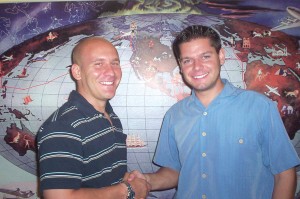
L to R: Captain Jon Witkin, an Air Force F-16 fighter pilot, and Brian J. Terwilliger grew up together in Connecticut, fascinated with airplanes.
“Four years ago, I was inspired to tell this story before the world loses these aviators,” said Terwilliger. “I wanted to archive the 75 years of history, people and aircraft of this fascinating airport that I call home. It’s a film for anyone who has ever looked up and dreamed of having wings.”
Terwilliger says “pilot or fearful flyer will experience the most beautiful and uplifting story of a real life airport that has an un-matched diversity of well-known people, exquisite aircraft and a history so rich it’s hard to believe.”
He has also tracked down rare footage from a half-century ago, as well as never-before-seen negatives that date back to the airfield’s 1928 opening. Produced and financed by independent means, the passion-filled film remains very true to its desire to create awareness, arouse interest and infect excitement in an audience that is not aviation-oriented.
The film will be released in movie theaters and will soon after be available on DVD, which will be chock full of DVD extras, deleted scenes and a behind-the-scenes featurette. The DVD price is not yet set, but will be comparable in price to a standard feature film.
“Theatre distribution is in the works; we’ll probably be out around the same time as Martin Scorsese’s ‘The Aviator,’ a movie about Howard Hughes,” Terwilliger said.
He said “One Six Right,” however, will most likely start with a limited release.
Brian J. Terwilliger
Despite his young age, and various obstacles and distractions thrown in his path, Terwilliger is the visionary and producer/director/pilot behind this film.
Terwilliger was introduced to general aviation only nine years ago.
“I recall my first flight in a small airplane,” he said. “It was with Jon Witkin. We grew up together in Connecticut; we’re only two months apart in age. We were fascinated with airplanes; we built model airplanes, radio-controlled airplanes, and were fascinated by the movie ‘Top Gun,’ and pretty much anything aviation.
“Jon and I always wanted to get our pilot’s license, and he started when he was 15, using the money he earned from working at McDonald’s. My parents wouldn’t allow me to even touch a small airplane or have anything to do with a small airplane while I was living under their roof.”
Shortly after Witkin started his flying lessons, Terwilliger, at the time 16, moved to California. When Witkin was 19, he called to tell Terwilliger he had his private license and told him to come out to the East Coast to take a ride.
“I was out here jealous of the whole thing,” Terwilliger said, adding that he went and took the ride.
“We went up in a Cessna 172, took off out of Connecticut, and Jon took me on one of his favorite flights,” he said. “We flew down the Hudson River and circled the Statue of Liberty at 500 AGL (feet above ground level). The whole time I was looking over in the airplane at my friend Jon, the guy I grew up with, and there he is, a pilot in this airplane. I just couldn’t believe it! I was inspired beyond belief!”
That was December 1995. A few days after Terwilliger, who was still living at home, got back to California, he got out the Yellow Pages.
“I was still under the pressure of the lack of support of my parents, but I had a car, I had money, and I had the will,” he said. “I was working in the film industry. I had established some income from low-level production work since I was 19, in the summer of ’95, just out of high school.”
Within a week, he started his first flight lesson at Van Nuys Airport—to his parents’ disapproval.

Clay Lacy’s DC-3, which is based at Van Nuys Airport, is like the one he flew many years ago as a pilot with United Airlines. It is one of the 13 airborne aircraft that took part in the film “One Six Right.”
“Three months later I soloed, and six months after that, I got my license,” he said. “I called Jon up and said, ‘Jon, come on out to the West Coast and I’ll take you up for a flight.’ So, less than one year after going up on my first light plane flight with Jon, in October 1996, he came out here and we went up in a 172 out of Van Nuys Airport. We had lunch in San Luis Obispo, flew up to Oakland, and flew over the Golden Gate Bridge, the West Coast equivalent of the Statue of Liberty.”
Jon Witkin
Terwilliger’s inspiration is now a captain in the Air Force, flying the F-16 “Falcon” in a fighter squadron. Witkin, originally from South Windsor, Conn., just outside Hartford, also has an inspiring story.
“My father was a civil pilot,” he said. “He took me up for my first flight when I was 15.”
At 16, he worked at McDonald’s, and with money he made, rode his bicycle to the airport to take flying lessons.
“I’ve been flying ever since,” said the 28-year-old captain.
He started ROTC when he was 20 and attended the University of Maryland for four years, graduating when he was 24.
“I went into the Air Force then as a second lieutenant and went through flight training as an officer at Columbus Air Force Base in Mississippi,” he said.
Flight training was a year long.
“It started out with twin jet Cessna T-37 ‘Tweets.’ Then we went to twin jet Northrop T-38 ‘Talons’ to train for the fighter track, with the instructor usually in the back seat,” he said. “I got my wings on graduation in 2002 from the T-38.”
Next, he went for three months to Introduction to Fighter Fundamentals, a course that teaches the fundamentals of dogfighting in T-38s, at Moody Air Force Base in Georgia. Then, he went to Luke Air Force Base, near Phoenix, to learn to fly the F-16 “Falcon.”
“That was a ten-month course,” he said. “Then I was sent to an operational squadron at Shaw Air Force Base in South Carolina. We practiced 50 percent air-to-air and 50 percent air-to-ground.”
Witkin is now in the active-duty 79th Fighter Squadron, “The Tigers.”
The film idea
Van Nuys Airport has fascinated Terwilliger since he started flying there in 1996.
“I’ve just never seen an airport that has the kind of diversity this airport has in terms of businesses and people that fly here today and in the past,” he said. “All that aside, the history alone is pretty fascinating. In the hundred years that flying has been around, very few airports have been around for over 75 years of it. They may have started earlier, but haven’t survived.”
December 17, 2003 was the 75th anniversary of what is now called Van Nuys Airport.
“It was dedicated on the 25th anniversary—to the day—of the Wright Brothers first powered flight,” Terwilliger explained.
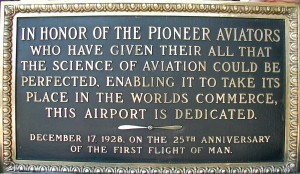
Originally called “Los Angeles Metropolitan Airport,” this is the dedication plaque presented on December 17, 1928 at what is now “Van Nuys Airport.”
He said his fascination with the airport is what prompted him to pursue the idea of a documentary—to start thinking about it, discussing it with people around the airport, and trying to garner support. A few other movie titles were considered, before “One Six Right” was chosen, since that is the number of the main runway used most frequently at Van Nuys Airport (although there is a shorter parallel runway—16L).
Terwilliger said the idea was conceived while visiting his sister, near Centennial Airport in Colorado, in February 2000. While there, he talked with Pat Wiesner, the owner of Wiesner Publishing, who has owned and flown several aircraft, and who was his sister’s employer at the time.
“I was in her office when Pat came in,” he said. “We struck up a conversation. He asked where I flew and I told him Van Nuys. He started telling me stories about flying in and out of Van Nuys Airport, and he asked if I had ever seen the movie, ‘The Bodyguard,’ with Whitney Houston. He says, ‘In the final scene of the film, with an airport, that’s Van Nuys Airport, and in the background you’ll see my airplane…'”
Terwilliger said it suddenly struck him that Van Nuys Airport wasn’t your average airport.
“As fascinated as I am with Southern California, I realized this really was an airport that had a story worth telling, with an interest much greater than just Southern California,” he said. “I have even verified with Warner Brothers that the airport and tower seen in the early part of the film ‘Casablanca’ was filmed at Van Nuys Airport when it was called Metropolitan Airport.”
Terwilliger said he e-mailed the Los Angeles World Airports from Colorado, and made his first inquiry through their website to the public relations department. He said he was a pilot that flew out of Van Nuys Airport, and was involved in the film industry, and that he wanted to make a video about the airport.
“I wanted to know what kind of pictures they had, and what kind of information or old film they might have,” he said. “They basically wanted to know more about the project. I didn’t get very far with them at first. I was trying to get support for the project, and trying to get people to back it, not only financially, but with their name and with some services, donations of any sort.”
Terwilliger said he continued to divide his work between the film industry—working on a variety of films from “Big Fish” to “The Core” to some commercials and other small projects—and the other half of his business, which is website development and design. He thought of placing an ad in the Van Nuys Aviation Business Journal, thinking it would be a way to reach people he hadn’t yet been able to, but didn’t think he could afford it. A short while later, a writer from the Journal called him.
“He said he understood I was in the process of doing a documentary on Van Nuys Airport, and would like to do a story on me,” Terwilliger recalled.
He recalled his excitement that he would get coverage, and that it was “free.”
The article came out in February 2003, and resulted in exactly what he had wanted.
“I got a wonderful e-mail from Jim Dunn, the owner of the Airtel Plaza Hotel,” he said. “I met with Jim for a three-hour meeting at the Airtel—a walk and a talk and a lunch. It was a very mutually beneficial experience. He said right then and there to count him in, and he would help any way he could. He helped with introductions, and he became one of the earliest investors in the project. Clay Lacy and Barbara Cesar were some of the initial supporters as well.”
Terwilliger said that in addition to some financial investors—profit participants—in a limited liability company, VNY Documentary, LLC, which he created and manages, he’s received a few donations. He said that prior to any investment, to a single check being written, and to starting the LLC, he had lunch with someone he’d wanted to meet for years. That was Phil Aune, “the voice of Van Nuys,” the well-known air traffic controller that has been guiding pilots for over 40 years.
“I had the privilege of meeting him last summer,” Terwilliger said. “We had lunch together one day and I shared with him about my project. After the lunch, he was so excited about what I was doing—inspired and supportive—he not only wrote me a letter that I received in the mail two days after our lunch, but he included a one hundred dollar check. He said, ‘I know this isn’t much, but I hope this helps.’ It was really the very first check of any kind ever written for this project, and I’m forever grateful to him. Ironically, to start the LLC bank account, it required one hundred dollars; that was the check that did it!”
He said that at that point, he hadn’t done any filming.
“Panavision, in Woodland Hills, California, is the largest manufacturer and supplier of camera equipment for the film industry; like Kodak is to film, Panavision is to the cameras,” he said, adding that there’s no relationship between Panavision and Panasonic. “There’s a high-definition camera now that is state-of-the-art—the same camera that George Lucas used on ‘Star Wars.’ Lucas helped co-develop it with Panavision. It’s a 16:9 aspect ratio, with very, very high resolution—almost six times the resolution of a regular TV. You can go right into a movie theater, and even IMAX. You couldn’t do this if you shot this for television; that quality wouldn’t suffice.
“Panavision made a wonderful donation of equipment on which we only pay the insurance. This has been an incredible gift, and to this day, for the entire project, they have committed to being a partner and helping me make this film, which has been fantastic.”
After learning about the project, Kevin LaRosa, a well known helicopter pilot in the movie industry as well as a P-51 owner on the airport and owner of Jetcopters, Inc., donated some helicopter time to do air-to-air photography. He donated his helicopter and his services as a pilot, as well as a camera called a Gyron, which is high-definition and gyroscopic on all three axes; it’s a ball that hangs from the nose of his helicopter.
“Many pilots have flown 13 different airplanes air-to-air for the film; all those pilots and all those airplanes and all that fuel has also been donated,” Terwilliger said. “We have some spectacular aerial sequences, all graciously donated. We currently have over 120 hours of footage, to be reduced to 90 minutes for the final film.”
In the past six to eight months, since he finished the trailer, LAWA has seen the work and its response has been positive.
“I was truly executing the vision I presented to them,” he said. “The film is going to highlight and show this airport in a wonderful way. They contacted me; in a few weeks time we worked out some arrangements where if I had the proper insurance and gave them some proper notice of where I wanted to be, what I wanted to do and what kinds of activities and camera placement I needed, they’d work with me to the best of their ability. They have, and they’ve done a really great job.”
He says the film ultimately depicts the passion of people that fly everywhere.
“It’s this passion and this pioneer spirit that has created this airport,” he said. “We’ve got documentation, like the dedication day list of ceremonies—the hour-by-hour happenings—and the original dedication plaque, a brochure of the airport that talked about the vision of the airport, and the marketing materials of the airport in the opening months. It was really eye-opening to see what the vision was, what the intentions were, and the incredible passion and spirit that were behind the people that started this place. Really, in no small way, that has continued through all decades—everything that has made this airport the busiest general aviation airport in the world!”
There are over 17,000 GA airports in the United States, yet only 600 commercial airports. GA includes fire-fighting aircraft, news helicopters, single-engine aircraft, business jets and aerobatic aircraft. Terwilliger explains that GA includes all flying except scheduled airlines and military.
“Charter is not a scheduled airline, so it is general aviation,” he says. “Every single operation here, even the 737s and 727s that fly out of here, are privately owned and operated and chartered. There are five 737s here and two 727s parked on the ramp right now—but no airline logos or markings.”
He said airport preservation is of real interest to him.
“The number one issue facing general aviation today is the fact that airports are going away, and need to be preserved,” he said. “They need to be appreciated and understood for the role they play in all of aviation. A lot of people understand how important the military is; people understand the importance of FedEx and other overnight services and the airplanes that support that, and of course, everybody depends some way on the airlines—whether they’re flying to see Grandma, or Grandma is flying to see them. But all of those operations require GA; it’s the foundation for all those things that we depend on. Most pilots learn to fly in small airplanes from small airports—just like Van Nuys.”
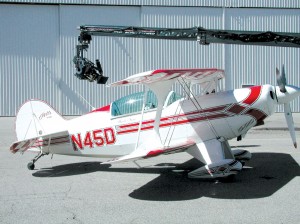
Many close-ups of aircraft on the ground used a camera attached to a telescopic boom. This Pitts S-2B did aerobatics, closely ollowed by the camera in startling footage.
Terwilliger is particularly proud to have maintained total independence throughout the entire film creatively, as well as with the choices that are made on a day-to-day basis.
“The investors and sponsors that I have, including a major sponsor that has come on board, Cessna Aircraft Company, all believe in me and in the vision and the film I’m executing,” he said. “They do not have any creative control or creative say. I believe that is in the total interest of making the best possible film.”
He said that’s because if “several cooks were running the kitchen,” they’d be trying to make three or four different films in one.
“You need to make one film,” he said. “The only way to do that is to get people to get behind you, and to believe in you, and to say they trust that the decisions you’re going to make are going to make the best possible film.”
In late August, Terwilliger launched a website for this project—www.onesixright.com.
“You can go there to get an overview of the project,” he said. “You’ll always have the latest information about the status of the film and when it will be released. There are behind-the-scene pictures, historical pictures, screen shots from the actual film, and the movie trailer is available online. Every background on every page of the website is actually a still image grabbed from the film itself.”
Within a week and a half after the website was up, Terwilliger had already gotten hits from Sweden, Switzerland, Norway, Japan, Australia, Germany, Belgium, Turkey, Croatia, Canada, Austria, the UK and Argentina. During that period, 250 people also reserved a copy of the DVD.
He said the momentum with the film right now is very exciting.
“I’m now starting to get phone calls before I’m even calling people on these subjects,” he said. “People are suggesting this needs to go to IMAX; the very few people on the inside that are getting to see some of the footage are convinced that there is no other format, no other place for this to be seen other than a movie theatre. Television would be too small. This is an epic film about aviation, and it’s an epic story with beautiful photography.”
He said the product is for a general audience.
It’s not just for pilots, and it’s certainly not just for the Van Nuys area,” he said. “I’m very confident that the story—the history, the passion and the diversity that this airport has, which no other has—is going to be of interest, especially in the entertaining way we’re presenting it. The imagery will be compelling and the passion will be infectious to a wide audience that is not aviation-oriented, and that is not associated with, or even knowledgeable about this airport.”
- Kevin LaRosa’s P-51 Mustang piloted by Matt Jackson.
- This Douglas A-26 “Invader” was one of 13 aircraft shown in close air-to-air formation and fly-bys in the film.
- Over $300,000 worth of Panavision camera equipment was loaned for use in filming “One Six Right.”
- Lorenzo Lamas was one of 70 people interviewed for “One Six Right.”
- Kevin LaRosa’s helicopter, equipped with a gyroscopically stabilized Gyron camera, was used to film unique in-flight close-ups.
If you’d like to be notified about theater locations, dates and times, or you would like to reserve a DVD in advance, please visit [http://www.onesixright.com]. In addition to receiving information via e-mail upon availability, completing the form also grants you instant access to a sample three-minute aerial sequence of original photography featured in the film.











